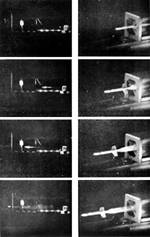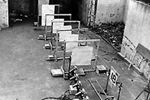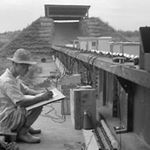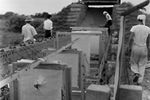After confirming internal burning pressure of 112
atm, burning duration of 63 msec, thrust force of 29 kg, etc., in
the factory, the horizontal test launch of Pencil was carried out
on March 11 at a gun firing pit in Kokubunji, Tokyo, followed by
an open firing test on April 12 in the presence of people from government
offices concerned and the press corps.
Launched horizontally from a 1.5m-long launcher, the
Pencil flew through a series of thin-wired paper screens to pierce
the sandpit beyond the screens. The velocity change of Pencil was
estimated by measuring the time difference of wire cuttings using
an oscillograph. The direction change of tail fins gave the spin
rate. Supported by high-speed cameras, in addition, basic data for
future flight tests were obtained, for example, velocity, acceleration
and trajectory dispersion due to changes of the center of gravity
and the shape of the tail fins.
This kind of horizontal flight tests lasted for 10
days, and the results of all 29 flights were satisfactory.
After the tests at Kokubunji, some variations were
made, such as a 300 mm long Pencil ("Pencil 300"), a two-stage Pencil,
and a tail-finless Pencil. To gain experience, more horizontal test
flights were attempted at a laboratory attached to the University
of Tokyo in Chiba City.
After these experiments, the next stage of rocket
launchings shifted to Michikawa Beach (currently lwaki-cho), in
Akita Prefecture. Michikawa continued to be a stronghold for Japanese
rocket technology from August 1955 to 1962. The historical first
trial at Michikawa was made on August 8 under a clear sky. A Pencil
300 was put on a 2 m-long launcher. Launch elevation was set at
70 deg. Itokawa started the countdown at 14:15. "Five, Four, Three,
Two, One, Zero!" Lift off occurred at 14:18. But then someone exclaimed
"Oh dear!" Just before ignition, owing to weak tail support with
vinyl tape, the Pencil had dropped onto the beach. Instead of flying
up into the blue sky as expected, the Pencil was crawling along
the sandy beach like a pinwheel.
Of course, the tail support was strengthened with
wire, and another attempt was made at 15:23. The Pencil, for the
first time, took off toward the hot sky of summer, leaving a line
of beautiful and thin white smoke. With a peak altitude of 600 m
and a horizontal range of 700 m, the flight time of this historical
first success was 23 sec. |




|